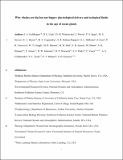Why whales are big but not bigger : physiological drivers and ecological limits in the age of ocean giants
Abstract
The largest animals are marine filter feeders, but the underlying mechanism of their large size remains unexplained. We measured feeding performance and prey quality to demonstrate how whale gigantism is driven by the interplay of prey abundance and harvesting mechanisms that increase prey capture rates and energy intake. The foraging efficiency of toothed whales that feed on single prey is constrained by the abundance of large prey, whereas filter-feeding baleen whales seasonally exploit vast swarms of small prey at high efficiencies. Given temporally and spatially aggregated prey, filter feeding provides an evolutionary pathway to extremes in body size that are not available to lineages that must feed on one prey at a time. Maximum size in filter feeders is likely constrained by prey availability across space and time.
Citation
Goldbogen , J A , Cade , D E , Wisniewska , D M , Potvin , J , Segre , P S , Savoca , M S , Hazen , E L , Czapanskiy , M F , Kahane-Rapport , S R , DeRuiter , S L , Gero , S , Tønnesen , P , Gough , W T , Hanson , M B , Holt , M M , Jensen , F H , Simon , M , Stimpert , A K , Arranz , P , Johnston , D W , Nowacek , D P , Parks , S E , Visser , F , Friedlaender , A S , Tyack , P L , Madsen , P T & Pyenson , N D 2019 , ' Why whales are big but not bigger : physiological drivers and ecological limits in the age of ocean giants ' , Science , vol. 366 , no. 6471 , pp. 1367-1372 . https://doi.org/10.1126/science.aax9044
Publication
Science
Status
Peer reviewed
ISSN
0036-8075Type
Journal article
Description
This research was funded in part by grants from the National Science Foundation (IOS-1656676, IOS-1656656; OPP-1644209 and 07-39483), the Office of Naval Research (N000141612477), and a Terman Fellowship from Stanford University. All procedures in USA were conducted under approval of the National Marine Fisheries Service (Permits 781-1824, 16163, 14809, 16111, 19116, 15271, 20430), Canada DFO SARA/MML 2010-01/SARA-106B, National Marine Sanctuaries (MULTI-2017-007), Antarctic Conservation Act (2009-014, 2015-011) and institutional IACUC committee protocols. Fieldwork, data collection and data processing for M. densirostris were funded by the Office of Naval Research grants N00014-07-10988, N00014-07-11023, N00014-08-10990, N00014-18-1-2062, and 00014-15-1-2553, and the U.S. Strategic Environmental Research and Development Program Grant SI-1539. PLT gratefully acknowledges funding from funding the MASTS pooling initiative (The Marine Alliance for Science and Technology for Scotland). MASTS is funded by the Scottish Funding Council (HR09011) and contributing institutions.Collections
Items in the St Andrews Research Repository are protected by copyright, with all rights reserved, unless otherwise indicated.

